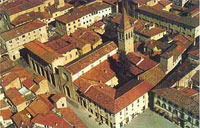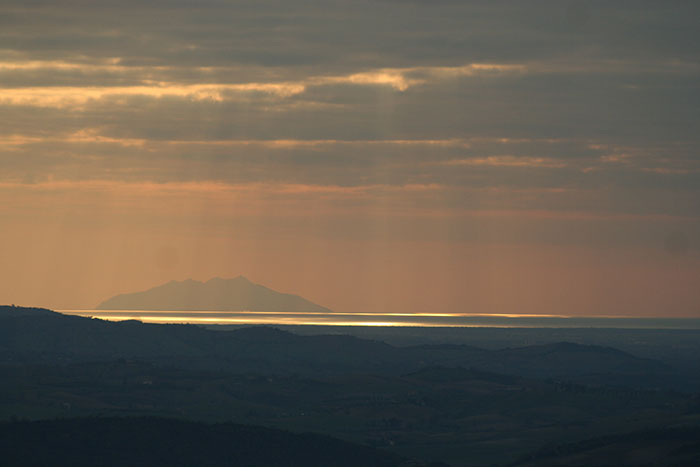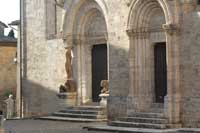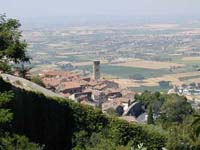 |
| Paolo Ucello, Funerary Monument to Sir John Hawkwood, 1436, fresco, 820 x 515 cm, Duomo, Florence ` |
|
| In 1436 the administrators of the Opera del Duomo in Florence commissioned Paolo Uccello to paint a fresco in the Cathedral, a monument commemorating the English soldier of fortune Sir John Hawkwood (Giovanni Acuto for the Italian) who had died in 1394; Hawkwood had led the Florentine troops to victory in the battle of Cascina (1364). Still in the Cathedral today, the fresco was restored in 1524 by Lorenzo di Credi, who added the elegant frame with the grotesque pattern decorations.
The fresco is a splendid example of how Uccello used the new means of expression (perspective and sculptural quality) in a totally personal way; adding to them the monochrome effect of "terra verde", the painter has succeeded in creating the illusion of a statue, standing on a plinth. The base is shown in foreshortening, so as to be seen correctly from below, whereas the warrior in on his horse is drawn in full frontal perspective. This seemingly contradictory use of the rules of perspective, which has given rise to innumerable debates, is further evidence of the originality of Uccello's language. The unnatural movement of the horse, which is raising both its right legs at the same time, was pointed out as a serious mistake by Vasari, but it is justified by the consistency of Paolo's perspective construction. In the Monument to Sir John Hawkwood there are also some elements derived from Masaccio's painting, like the trompe 1'oeil perspective of the base, very similar to the base below Masaccio's Trinity, and the sculptural relief of the horse and the rider created with a strong chiaroscuro. And furthermore, as in all Masaccio's works, the light comes from the left and is very natural. But there are just as many elements that clearly distinguish Paolo's art from Masaccio's: Uccello's realism is much more analytic than synthetic, in other words it is more similar to the late Gothic style than to Masaccio's. Uccello's analytic realism blends extremely well with his geometrization of forms, which contributes to the overall effect of abstractism conveyed by his works. In other words Paolo's compositions are more abstract and symbolic than natural: this painting is more a portrayal of the idea of a warrior than of a warrior in flesh and blood. The administrators of the Opera del Duomo did not appreciate the fresco at all, and ordered Uccello to paint it again, which the artist did. We do not know exactly what Paolo changed, but he probably just toned down the colours, which were considered too bizarre. n 1436 in the Florence cathedral, Uccello completed a monochrome fresco of an equestrian monument to Sir John Hawkwood, an English mercenary who had commanded Florentine troops at the end of the 14th century. In the Hawkwood fresco, a single-point perspective scheme, a fully sculptural treatment of the horse and rider, and a sense of controlled potential energy within the figure all indicate Uccello's desire to assimilate the new style of the Renaissance that had blossomed in Florence since his birth. Following the Hawkwood monument, in 1443 Uccello completed four heads of prophets around a colossal clock on the interior of the west façade of the cathedral; between 1443 and 1445 he contributed the designs for two stained-glass windows in the cupola. |
| A British interloper is memorialized in the Italian sanctuary of the Duomo, in Florence. The inscription under the huge fresco reads (translated), "John Hawkwood, British knight, most prudent leader of his age, and most expert in the art of war".
In May of 1364, he led some 10,000 men and 3000 horses and surrounded the walls of Florence in a month-long siege during which they burned surrounding farmlands and homes. Finally, his men were paid a fortune to leave. In July of that year he set out again against Florence, but suffered his first major defeat. This was the beginning of a path that led to being the hero of Florence. The condottiero John Hawkwood was a veteran of the Hundred Years War, and a ruthless mercenary leader who commanded private armies of thousands, attacking cities in Italy on behalf of the highest bidder. He was known for his cunning and (relative) restraint. In the company of men even more bloodthirsty than him, he seemed a better businessman than most, often extracting enormous ransoms from cities under siege rather than going through the bother of sacking them. Of course, in order to wield that kind of threatening power, you need a really deadly reputation, which he also had in spades. Hawkwood rose to power during the lawless years of plague and corruption in Italy in the middle of the 14th century, famously called "the calamitous century" by scholar Barbara Tuchman. Not a country, but a hodge-podge of kingdoms, independent republics, and wealthy walled city states, there was endless bickering and grabs for land and power between them. With the pope up north in Avignon, whatever ability the Holy Roman Empire had to control events in the center of the peninsula disappeared. Enter the mercenaries. The Hundred Years War started between France and England as a fight over the crown in 1328 came to a pause in 1360 due to a truce. It seemed the war had finally ended (it actually dragged on well into the next century). Out of work, thousands of English soldiers headed home, but others chose to stay and go into business for themselves. These highly trained military men, their horses, their equipment, and their assorted hangers-on began to form their own private armies, known as "free companies", and went looking for work. Hawkwood first formed the Great Company, then later took over the White Company from another mercenary (basis for Sir Arthur Conan Doyle's book The White Company), and moved down into Italy. Over the years he fought against the pope, and for the pope, against the powerful Visconti of Milan, and then for them, eventually marrying a Visconti daughter. Finally he started moving around cities in Tuscany, and was employed by Pisa against their nearby enemy: Florence. For twenty years after his 1364 siege of Florence and subsequent defeat he followed the money from city to city, finally coming into the employ of Florence in 1390. He died there 1394 and was regarded as a Florentine hero. Even before he died, the city was hatching plans for a grand statue to honor him, in the tradition of the Ancient Roman equestrian statues, then very much in vogue. Amidst dithering and plan changes, a first fresco was painted in the (still domeless) Duomo, while the statue plans were sorted out. By 1436 it seems all plans had been scrapped, and the well known painter Paolo Uccello was brought in to give the fresco a proper overhaul. Uccello was best known for his detailed gothic style, and an obsession with perspective, so it is strange to note that when looking at the fresco the statue appears to be in line with the viewers eyeline, while the base of the horse statue is seen from slightly below. Uccello was asked to repaint his first version of the fresco, possibly to reduce the military stance of the first draft into a more parade-like stance, or possibly to adjust the perspective to make less of the horse's anatomy visible in the church. The minimal coloring of the painting and the deathly pallor of the rider have led some to speculate that Hawkwood is here intended to be an allegory of Death, the fourth horseman mounted on his pale horse. After his death, Richard II of England requested that his body be returned to England, but it is uncertain that it ever happened. He may still be interred in an unmarked spot under the floor of the Duomo, his original resting place. If he was returned to England, he is most likely interred near the small carved memorial arch on the wall in the church in his hometown, St. Peters in Sible Hedingham, England. Also in the Duomo is another, very similar painting of another condotierro, Niccolo da Tolentino, also by Uccello. |
|
||||
|
||||
Podere Santa Pia |
Podere Santa Pia, garden view, December |
San Qurico d'Orcia |
||
 |
||||
Cortona |
Sansepolcro |
|||
| The town of Cinigiao is just across the valley, and the Abbey od Sant'Antimo, Montalcino, Pienza and Montepulciano are within easy driving distance. The house has been beautifully restored to create spacious, stylish rooms combining elements of rustic tradition with modern comforts. It has terracotta tiled floors and beamed ceilings.and breathtaking 300 degree views of the Maremma hills. Podere Santa Pia creates a perfect platform from which to enjoy the breathtaking scenery of this unique part of Italy. |
||||
 |
||||
Podere Santa Pia is a beautifully renovated holiday house, located in a panoramic position, offering its guests a breathtaking view over the Maremma hills. On clear days or evening, one can even see Corsica.
|
||||
Orvieto is one of the principal sights of the region of Umbria, Italy. Its situation is marvelous - perched high above tufa cliffs - showing traces of every phase of history for the past three thousand years, culminating in its magnificent cathedral. Tourists should on no account miss Orvieto if they are visiting Umbria or southern Tuscany. The tufa butte on which Orvieto is located is itself riddled with tunnels and wells dating from Etruscan times to only a couple of hundred years ago. The most spectacular of these subterranean burrowings is the Pozzo di San Patrizio, a deep well with a double spiral stair leading to the water source at its base. It dates from 1537 and is 62 m deep. If you're in need of exercise, it's possible to descend and return. Try carrying up a couple of buckets of water - it'll bring the life of earlier times vividly before you. |
||||





